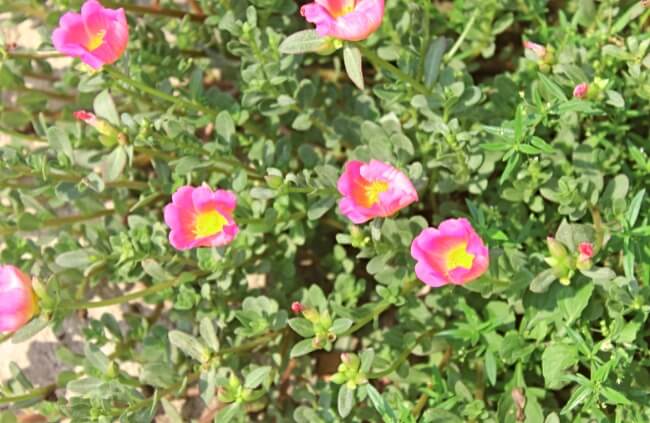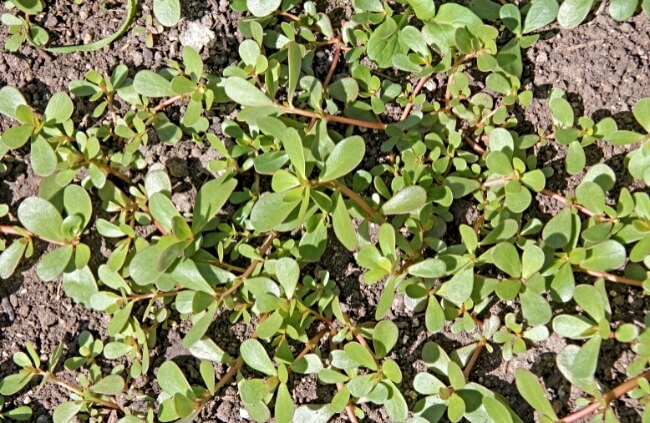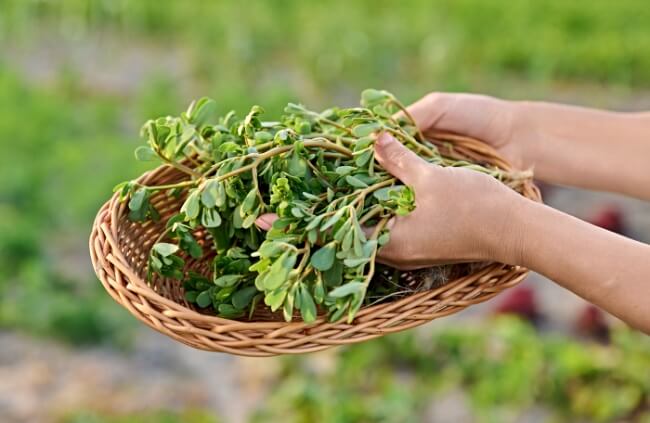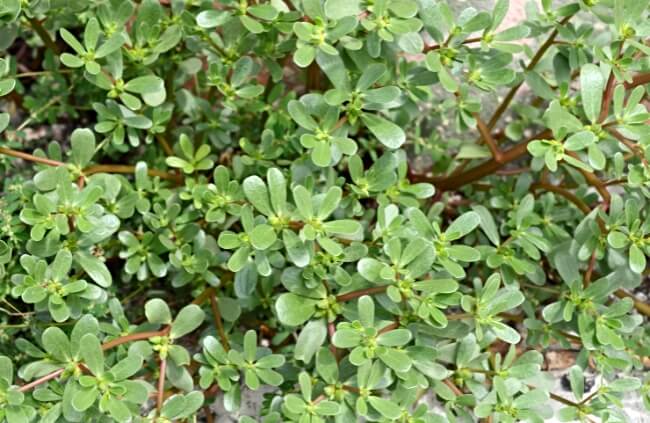Portulaca oleracea, commonly known as Purslane, is a sub-tropical Australian native which doesn’t often get the credit it deserves. If you’re looking for an addition to an authentic bush food garden, purslane will prove its value year after year.
This unassuming plant really does look after itself but will reward you with a strong supply of spinach-like salad leaves packed with nutrition.
More...

Family: | Portulacaceae |
|---|---|
Genus: | Portulaca |
Species: | P. oleracea |
Common names: | Little Hogweed, Pigweed, Munyeroo, Pursley, Wild Portulaca, Children’s Spinach, Common Purslane, Red Root |
Origin: | Various native ranges |
Location: | Outdoor |
Type: | Herbaceous Annual |
Growth: | Up to 1m |
Sun requirements: | Full sun |
Foliage colour: | Green |
Flower colour: | Pale yellow, pink or white |
Flowering: | March to November |
Edible parts: | All parts are edible |
Maintenance level: | Low |
Poisonous for pets: | Poisonous cats and dogs |
What is Purslane?
Purslane is a fast-growing herbaceous annual that is often considered to be a weed, casually overlooking its nutritional benefits. This fleshy, red-stemmed, herb grows on all continents, all over the world, except for Antarctica and is a voracious self-seeder, a clue to its success. It has ovate-shaped, juicy leaves similar to that of a jade plant.
Its name derives from the Latin ‘portare’, to carry and milk (lac), referring to the milky sap that exudes from a lot of plants that are poisonous lookalikes. Purslane does have a form of sap and is considered to be a succulent, but it is clearer to greenish, exuding from both the stems and leaves.
This sap is a definite way to tell your edible and nutritious purslane apart from the poisonous spotted spurge (Euphorbia maculata) which confusingly enough has the common name milk purslane. If the sap is green, it is edible.
Note: The name ‘purslane’ is also used for two other plants of a different genus, named Claytonia. You may be forgiven for any confusion as Claytonia purslane is a totally separate genus.
Claytonia sibirica (also known as pink purslane) originates from Siberia and Claytonia perfoliata (commonly known as miner’s lettuce) comes from mountainous regions of North America.
What is Purslane’s Natural Habitat?
Purslane is mostly found in the northern regions of Australia, Queensland and northern New South Wales, and can be found naturalising in almost all habitats.
Its naturally prostrate growth ensures the plant receives as much sun as possible, so it typically thrives in sunnier places, where it grows without strain. You will often find them cropping up along roadsides, verges and disused spaces where they have been left to colonise.

Other Types of Purslane to Grow
There are several other types of purslane that you can grow at home, and most grow in similar conditions to Portulaca oleracea. However, two distinct groups, winter purslane and sea purslane, are different in how, where and when they grow.
All can be used for the same edible purpose, and sea purslane has a salty flavour (which is obviously at its best when harvested from its natural coastal habitat). But winter purslane grows in a variety of soil conditions, like Portulaca oleracea, and includes several plants in the Claytonia genus. But despite its similarities, Claytonia grows with a very different habit.
Claytonia spreads as small plants, covering dense areas of soil, rather than single trailing plants, and it flowers more vigorously. The leaves are highly decorative when the plant is in flower, with individual white blooms developing from the stems in the centre of large symmetrical leaves.
Common Uses for Purslane
Purslane has very typical succulent leaf characteristics that, in nature, allow it to store water and cope with drought, but it has countless benefits in cultivation too.
Its mucilaginous leaf sap can be used to relieve skin irritation and speed up healing. The cooling nature is similar to an aloe and can be a soothing rub for eczema or psoriasis.


Get Your Free Guide:
Master Growing Australian Natives eBook
A Must Have Complete Guide for Every Australian Garden
Get Your Free Guide:
Master Growing Australian Natives eBook
A Must Have Complete Guide for Every Australian Garden
Purslane is also often used as a temporary relief for mouth and throat ailments. The mucilaginous sap can help coat the throat and moisten a chronically dry mouth.
Edible Uses & Identifying Purslane
The most common use for purslane is as an edible herb or salad leaf. Once purslane is established the leaves can be harvested throughout the year, so it is an invaluable source of food during less abundant times of the year.
Indigenous Australians use purslane in many foods including a ground-up paste that is added to bread to make a ‘damper’, but it is also used widely across the world as a salad crop.
The leaves can be eaten raw and cooked. Purslane seed is also in such ample supply that it can be used as a flour or filler ingredient. After grinding up seed and mixing with other flours or moulding into seed cakes it is a nutritionally useful, and filling bush tucker – but not one that’s going to win any culinary plaudits.
How to Grow Purslane in Australia
Said to have a sour and tangy almost lemon-like taste, purslane’s flavour can change depending on the time of day it is picked. The tangy taste is more noticeable when leaves are picked early in the day.
This guide offers tips for harvesting and using the leaves and stems of purslane, but first, we’ll look at how to plant, propagate and care for this resilient and easy-going crop.

Where to Plant Common Purslane
Portulaca oleracea forms a main taproot with branching smaller, more fibrous roots coming from it. This means that it can tolerate drought and damage, including growing back when weeded out.
Purslane’s reputation does itself no favours as it has been noted to be within the top 10 most noxious weeds in the world. However, I find this unjust and a testament instead to the ability of the plant to adapt.
Within a garden setting, with the presence of an astute gardener, it has little chance to overtake. That being said, if you have a relaxed approach and don’t mind your purslane spreading, happily watch on as it self-seeds, but possibly plant it away from, and weed around anything it could potentially smother.
Light & Temperature
The best position to plant your purslane is in receipt of full sun, or as much as possible. Its active growing season is usually the hottest four months of the year. During this time it will flower and set seed.
Temperature is an important factor in the purslane life cycle so if you want the plant to thrive and produce seed consider its planting location. It will reward you with pale yellow flowers from November through to March.
Soil & drainage
Purslane will grow in almost all soil mediums and will take drought in its stride. Its preferred ground would be in a fertile and well-drained substrate with a regular supply of water. However, being a succulent, it prefers to not sit in waterlogged soil.
Note: Beyond its edible and medicinal uses, consider using purslane and a soil conditioner. Its tap root will grow deep and break up your compacted soil in preparation for other crops, and can actually remove salt from cultivated ground.
How to Propagate Portulaca oleracea
Portulaca oleracea is easily grown from both cuttings and seed. Seed is incredibly viable with reports of it lasting up to 40 years before germinating. While the seed is dormant, it can tolerate widespread temperature from -15°C to 50°C and still remain viable. However, when germinating, higher temperatures are beneficial.
Purslane's success in reproduction by seed is demonstrated in various case studies, which have found that as many as 240,000 seeds can be produced by a single plant during its life cycle.
Purslane Propagation from Seeds
Seeds germinate best when avoiding the coldest months, so sow in spring or autumn for optimum results. The optimum temperature for successful germination is around 20-25°C.
Surface sow with a light sprinkle of peat-free compost and seedlings should emerge at 10-20 days.
If sowing in seed trays or pots, pot on carefully when the seedlings are large enough to handle, as they are delicate at this stage. If sowing directly outdoors or in their final position, thin seedlings after germination to 15cm apart.
Propagating Purslane from Cuttings
Vegetative reproduction is easy as Portulaca oleracea can naturally regenerate from broken pieces of its stem. For more chance of success, take cuttings from more established plants, which will root from any included node.
Cuttings should be 10-20 cm long, and can either be layered into pots of compost while still attached to the plant, or removed and inserted into gritty peat-free compost, when they should root within a week, and show vigorous new growth after 3-4 weeks.
Store cuttings somewhere warm, but out of direct light, and mist daily until roots establish.
Propagating Purslane by Division and Root Cuttings
Purslane has a regenerative taproot that if broken whilst weeding, can rapidly regrow. In most cases, this is frustrating for gardeners trying to manage and maintain purslane in the garden, but there are benefits to it.
If you dig up a mature purslane, it can be grown on and revived by removing the top growth entirely and planting the root into moist compost. Purslane can be propagated by dividing clumps of the plant in spring too.
Caring for Purslane
Purslane needs almost no ongoing care once it has established, making it a great choice for low-maintenance edible gardens. This perennial herbaceous subshrub enjoys full sun, and watering throughout summer, but should not need feeding at any point during its lifetime.
If there are signs of weakened growth, dropping leaves or dry stems, sprinkle a small amount of lime on the soil around the base of the plant to boost alkalinity, and support its natural nutrient uptake.
Pruning Purslane
Purslane requires little to no pruning unless for propagation purposes or to remove any damaged or diseased stems. However, it is useful to deadhead purslane religiously if you want to prevent it from self-seeding.
As soon as flowers fade, remove them to prevent seeds from developing, or cut the whole plant back after flowering, which will trigger new growth and delay seed development further.
Repotting Purslane
Purslane grows well in pots so occasional repotting with some added peat-free compost will ensure continual healthy growth. Only pot on in small increments, increasing the pot size by no more than two inches each time.
If the wasted compost remains damp around the edge of the pot it can cause root rot.
Harvesting & Storing Purslane

Younger leaves are at their best and strongest tasting when harvested early in the day. However, this is due to the malic acid content, so if you suffer from any kidney issues it is best to harvest later on.
Purslane is highly nutritious because it is unusually rich in omega-3 fatty acids, five times more than spinach, so is a valuable addition to anyone's diet, not least vegetarians. Portulaca oleracea is a definite superfood with significant amounts of antioxidants, vitamins A, C, calcium, iron, magnesium, and potassium.
There is no good way to store purslane. It will keep in the fridge for a maximum of one week before losing its texture completely, and freezing is not an option unless you are freezing soups or casseroles with purslane cooked into the mix.
If you extract the sap from purslane as a soothing gel, you can freeze that into ice cubes for an even more soothing treatment for rashes or eczema.
Common Purslane Pests and Diseases
As well as slugs and snails, which can be controlled by fastidious nighttime checks, or beer traps, there are two deliberately introduced pest species that harm purslane.
One is the purslane sawfly (Schizocerella pilicornis), which was introduced in Australia to control Portulaca, with the view that it was a spreading weed. It does help to manage the population of this potentially unwanted plant around the country but is frustrating for gardeners trying to grow it as a crop.
The other is the leaf miner weevil (Hypurus bertrandiperris) which is another introduced biological control agent. It is less damaging to purslane than sawfly but can spread fungal issues and create wounds that are likely to let infection into the plant.
Both can be controlled by natural predators, but as an edible crop, you should avoid spraying insecticides on purslane.
There are no distinct diseases to look out for with purslane, and it is very tolerant of disease when it happens. Avoid overwatering, and plant in well-drained, sunny conditions and it should remain untouched by disease.
Purslane Frequently Asked Questions
What parts of purslane are edible?
Every part of the purslane plant is safe to eat, but the leaves and flowers are the most palatable. The stems are fleshy and succulent and can be used in the same way as the leaves, and even after harvesting roots, it is quite likely that any part of the root left in the ground will regrow.
What is another name for purslane?
Purslane goes by many names, but pusley and little hogweed are the most common alternatives, and there are many alternative purslanes that grow in different conditions, including sea purslane and water purslane, which have a similar texture and flavour.
Is it ok to eat purslane raw?
Purslane is a succulent perennial herb that can be eaten raw or cooked. It has a mucilaginous texture when eaten raw, so using flatter leaves is more palatable if using it raw in salads. The plumper leaves and stems can be diced and cooked to thicken and add a salty, lemony flavour to soups.
Where can you find purslane?
Purslane can be found growing all over the country, in grasslands, roadside verges, coastal flats, gardens and parks. It will grow between cracks in paving, and even in woodlands – though it prefers to grow in full sun.
Is purslane a superfood?
The term superfood gets thrown around quite loosely these days and is often applied to the simplest of vegetables, but purslane is most definitely a superfood.
It is high in vitamins A and C, effective antioxidants, supports the body’s immune system, and your ability to heal yourself. Its non-edible uses even include soothing burns and relieving skin inflammation.

Is purslane a laxative?
In large quantities, purslane can have a laxative effect. For most, that might be quite unappealing, but it is a useful food to support constipation relief. If you want to avoid those effects, keep your portions small.
How much purslane can you eat in a day?
Purslane is a great addition to any diet, but it should be eaten in small amounts, as a flavour enhancer, and considered more of a seasoning than a main ingredient. It contains calcium oxalate, which contributes to kidney stones.
Is purslane good for the garden?
Purslane is good for the garden, offering a way to stabilise slopes and earth, and helping to improve soil structure. However, it also spreads readily into lawns, so does require some control.
Can purslane be a houseplant?
Purslane can be grown indoors, as a houseplant, or in a windowsill herb garden. It requires good drainage and good ventilation in these conditions. Treat it similarly to other succulents and cacti by not watering too often. The leaves will droop and wrinkle when they are ready to be watered.
Is purslane toxic to pets?
Purslane is toxic to pets, and should not be grown in homes with cats, dogs, rabbits, or other small mammals who can access the foliage. It contains calcium oxalate, which causes kidney stones in humans and is indigestible in most small mammals, causing toxic effects even in small amounts.
If your pet eats purslane, consult your vet as soon as possible and keep an eye on their behaviour.
Find more bush tucker inspiration in our bush tucker guides.
Purslane is a Vibrant and Nutritious Addition to Your Garden
Portulaca oleracea is more nutritious than most other vegetables you can grow in an edible garden and is guaranteed to be less effortful. We know it is often seen as a weed and can be a nightmare if you find it in your lawns, but it can be controlled with regular mowing and selective weeding.
Overall, the benefits of growing purslane at home far outweigh the negatives, but if you are concerned about it spreading, grow it in pots and deadhead it as soon as flowers fade. The leaves are a sharp and refreshing addition to any meal, so why not give it a go?
Published on February 28, 2025 by Gary Clarke
Last Updated on August 26, 2025




